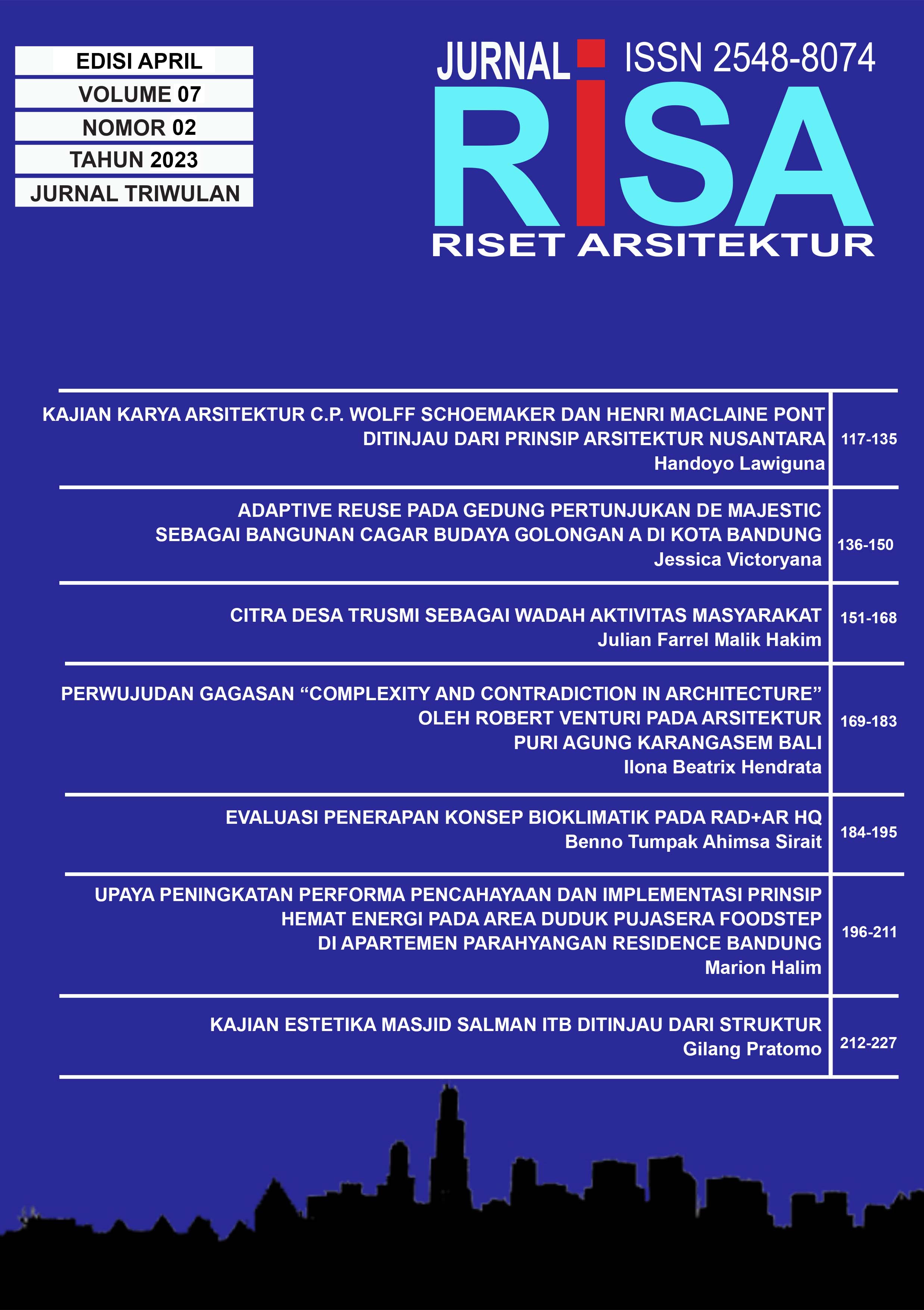IMPROVEMENT EFFORTS OF LIGHTING PERFORMANCE AND THE IMPLEMENTATION OF ENERGY-SAVING PRINCIPLES AT PUJASERA FOODSTEP SITTING AREA IN PARAHYANGAN RESIDENCES APARTMENT BANDUNG
DOI:
https://doi.org/10.26593/risa.v7i02.6606.196-211Abstract
Abstract - Lighting among various aspects, is crucial in facilitating users to carry out activities. Lighting can be categorized as decent, if it can meet the visual comfort standards in accordance to the demands of existing activities. One of the differentiating aspects in the lighting procurement strategy is the buildings’ typology. Each typology has different lighting characteristics, where a typically large room typology has a central area that is more difficult achieve natural lighting (Anasiru, 2016) and so it relies more on artificial lighting. However, there have been numerous findings and innovations in the use of natural lighting in buildings with similar typologies. This arises in response to concerns about the high level usage of energy in buildings, proving the need for an energy-efficient lighting system.
The object reviewed in this study is Pujasera FoodStep, a commercial area on the semi-basement floor of the Parahyangan Residence Apartment. The object of this research is filled with various food outlets and sitting areas, with an area of about 1250 m2. In addition to being used for eating activities, it is also often used for studying, doing college assignments, and holding discussions. This room with a rather large typology utilizes artificial lighting as the main light source, aside from several natural lighting strategies implemented in this area, namely side openings and light wells.
Fulfilling the quantity and quality standards of lighting become especially important at the Foodstep Pujasera, promoted by the management as a learning and working area in addition to dining area. This is made to be even more concerning with the existing state deemed uncomfortable visually based on initial observations.
Because of the high usage od artificial lighting in pujasera foodstep as a result of the large semi-basement space, a strategy is needed that can take advantage of existing natural lighting from side openings and lightwells so that it can lighten the burden of artificial lighting, especially considering existing conditions that do not seem to include the potentials of natural lighting in its system, where all the lights can be seen turned on throughout the day, even in areas near the openings.
The purpose of this research is to assess the level of visual comfort in the existing conditions, to seek proposed strategies related to artificial lighting to be able to fulfill visual comfort, and also to seek proposed strategies for collaborating artificial lighting and natural lighting in order to save energy.The method used is descriptive experimental, with a quantitative approach through simulation assisted by DIALUX Light Wizard, Curic Sun, and DIALUX Evo software.
Through this research, several conclusions were obtained. First, the lighting in existing conditions that rely on artificial light as the main lighting does not meet the standard of visual comfort. Second, is the creation of artificial lighting design that can achieve visual comfort. Third, is to propose a strategy that can collaborate artificial lighting with natural lighting in the Foodstep food court seating area.
Suggestions that can be given through this research is to consider the role of other elements aside from artificial lighting as aspects that also affect lighting in the room. The elements mentioned are the design of the side openings and lightwells, as well as the use of wall, floor, and ceiling materials.
Key Words: Lighting, visual comfort, energy saving, Foodstep foodcourt
Additional Files
Published
Issue
Section
License
Copyright (c) 2023 Marion Halim

This work is licensed under a Creative Commons Attribution-NonCommercial-ShareAlike 4.0 International License.












